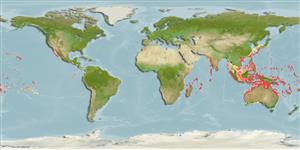>
Kurtiformes (Nurseryfishes, cardinalfishes.) >
Apogonidae (Cardinalfishes) > Apogoninae
Etymology: Apogon: Greek, a = without + Greek pogon = chin, beard (Ref. 45335).
More on author: Garman.
Environment: milieu / climate zone / depth range / distribution range
Écologie
marin récifal; profondeur 18 - 55 m (Ref. 37816). Tropical
Indo-Pacific. Replaced by Apogon coccineus from the Red Sea to Persian Gulf and by Apogon erythrinus in the Hawaiian Islands (Ref. 37816).
Taille / Poids / Âge
Maturity: Lm ? range ? - ? cm
Max length : 5.0 cm TL mâle / non sexé; (Ref. 90102); common length : 4.5 cm SL mâle / non sexé; (Ref. 37816)
Épines dorsales (Total): 7; Rayons mous dorsaux (Total): 9; Épines anales 2; Rayons mous anaux: 8. Distinguished by having the following characteristics: dorsal-fin rays VI-I, 9; anal-fin rays II,8; pectoral fin rays 13; pelvic fin rays I,5; pored lateral line scales 24; predorsal scales 5-6; large scale between first dorsal fin and lateral line 1; circumpeduncular scales 12; total gill rakers 15-16, developed gill rakers 8-9; full scale between first dorsal fin and lateral line 1, often with smaller second scale (Ref. 93839). Resembles A. unicolor but distinguished by fewer spines in the 1st dorsal fin (6 against 7), large scales, and fewer lateral line scales (23 against 25). Body color uniformly dark reddish, each scale mottled with brown. Attains 10 cm TL. Further characterized by having a semi-transparent red color, with a thin, dark red stripe on mid-lateral surface of the body (Ref. 93839) greatest depth of body 2.7-3.0 in SL (Ref. 90102).
Found on inshore reefs, lagoons, and seaward reefs (Ref. 37816). Nocturnal species (Ref. 7300). Feeds on small benthic crustaceans (Ref. 37816). Maximum depth reported taken from Ref. 57178.
Life cycle and mating behavior
Maturité | Reproduction | Frai | Œufs | Fécondité | Larves
Mouthbrooders (Ref. 240). Distinct pairing during courtship and spawning (Ref. 205).
Paxton, J.R., D.F. Hoese, G.R. Allen and J.E. Hanley, 1989. Pisces. Petromyzontidae to Carangidae. Zoological Catalogue of Australia, Vol. 7. Australian Government Publishing Service, Canberra, 665 p. (Ref. 7300)
Statut dans la liste rouge de l'IUCN (Ref. 130435)
Menace pour l'homme
Harmless
Utilisations par l'homme
Plus d'informations
RéférencesAquacultureProfil d'aquacultureSouchesGénétiqueElectrophoresesHéritabilitéPathologiesTraitementNutrientsMass conversion
CollaborateursImagesStamps, Coins Misc.SonsCiguateraVitesseType de nageSurface branchialeOtolithesCerveauxVision
Outils
Articles particuliers
Télécharger en XML
Sources Internet
Estimates based on models
Preferred temperature (Ref.
123201): 23 - 28.5, mean 27 °C (based on 152 cells).
Phylogenetic diversity index (Ref.
82804): PD
50 = 0.5000 [Uniqueness, from 0.5 = low to 2.0 = high].
Bayesian length-weight: a=0.01479 (0.00690 - 0.03171), b=3.09 (2.91 - 3.27), in cm total length, based on LWR estimates for this (Sub)family-body shape (Ref.
93245).
Niveau trophique (Ref.
69278): 3.5 ±0.50 se; based on food items.
Résilience (Ref.
120179): Haut, temps minimum de doublement de population inférieur à 15 mois (Preliminary K or Fecundity.).
Fishing Vulnerability (Ref.
59153): Low vulnerability (10 of 100).
Nutrients (Ref.
124155): Calcium = 281 [116, 644] mg/100g; Iron = 1.64 [0.79, 3.41] mg/100g; Protein = 18.4 [16.9, 19.9] %; Omega3 = 0.142 [0.053, 0.381] g/100g; Selenium = 52 [17, 138] μg/100g; VitaminA = 39.4 [8.1, 194.1] μg/100g; Zinc = 2.8 [1.6, 4.7] mg/100g (wet weight);
